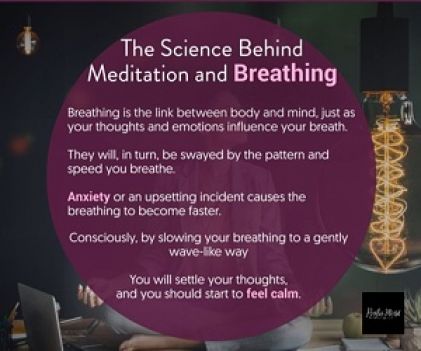- in Mindfulness by Tony
- |
- 2 comments
Discover the importance of mindful breathing.

Learn some exercises to help stay calm and focus
You might wonder: 'If breathing is automatic, why do I even need to think about it?' Well, we can all slip into habits - shallow breathing, for example, or holding your breath - that isn't always the most helpful.
More...
Breath-holding can also happen if you feel angry or upset, and you don't feel able to or are stopped from expressing your emotion. Even tight clothing or sitting down too long can restrict your breathing.
And then there's stress - over exams, friendships, parents or anything else - which can have a negative effect on your breathing pattern.
On the other hand, there's conscious breathing, where you take time to breathe fully and openly mindfully. Most toddlers live this way naturally - in a free and easy circular fashion, with no pauses between the inhale and exhale.
Humans are the only animals that start adding breaks in their breathing as they age.
For breathing well, there's a pay-off: studies show that better breathing can help improve your health and mood.
If you have anxiety, a breathing exercise or two can help relax you and calm the nervous system.

Are you feeling down?
Conscious breathing can energise and pick you up, help you to think more clearly, get to sleep more quickly, boost your confidence and even help your posture.
How to build awareness
A good starting point is becoming more aware of your breath and learning to relax into a pattern that feels right for you. The more you practise, the easier it'll become.
Find a quiet place and sit or lie down in a comfortable position.
Gently place one hand on your belly and one on your upper chest. Feel how your breath moves through your diaphragm - a dome-shaped muscle at the base of the trunk that plays a significant role in breathing. It contracts and flattens on inhalation and relaxes as the air is pushed out of the lungs when you exhale.
Notice how when you breathe in, your diaphragm contracts and moves down as it reaches the belly, which gently rises. That's good. A rising belly means you're using your diaphragm entirely, which is a healthy foundation for the breath. Then, the breath flows smoothly up from the belly, through the mid-section and into the upper chest, like a gentle, even wave.
As you exhale, your diaphragm tends to deflate gently. The movement is a relaxed one and comes from your abdomen - your chest, shoulders and neck shouldn't be so involved.
Breathing through the nose is best while at rest and during moderate movement as it cleans and warms the air as you inhale.
During exercise - which is also great for improving breathing - inhaling and exhaling through the mouth is most natural.
Just focusing on breathing for a few minutes in a quiet place will bring it to a calmer, more even rhythm, because slow, controlled breaths tell your brain there's nothing to fear, which makes positive changes to how you feel.
'Subconsciously we all know how to breathe well,' says breathwork and yoga teacher Aimee Hartley. 'We just need to spend a little time to remind ourselves how.'
Did we already mention that staring at a phone can make you hold your breath?
'While conscious breath-holding during professionally-led breathing exercises can be very beneficial. Consistent unintentional breath-holding can cause the brain to believe it's on standby to deal with a real threat, leaving us feeling anxious and stressed. The next time you're texting, scrolling, emailing, or tweeting, start to notice your breathing.
Try the following exercise, sit or lie down in a comfortable position.
Tune in and become aware of how you breathe:

The rhythm of the breath is flowing with no holding on.
The inhalation feels energising and effortless, and the exhale silent and smooth.
A full, healthy breath feels graceful and enlivening.
Exercise 1
- You're inhaling through the nose, how the diaphragm descends and the belly, lower torso and back expand softly and fully.
- The ribs expand outwards.
- The upper chest and upper back will lift slightly, near the peak of the inhalation.
- On exhaling, the air should exit from the nose, and the belly returns to its resting position.
- The ribs and upper chest will return to resting positions as the lungs deflate.
Exercise 2: Square breathing
For calm and focus:
The following exercise can help you feel more relaxed and calm. When you breathe in a slow, conscious way, you shift your attention from anxious thoughts and bring awareness back into your body.

Visualise a square and follow its lines in your mind.
Breathe in through the nose for four seconds, hold the breath for four seconds, breathe out through the nose for four seconds, hold the breath for four seconds.
Each time imagine going along each line of the square.
As the body calms down, you can shift from this exercise to merely being mindful of your breathing, without controlling the breath.
Repeat as often and for as long as necessary.

Exercise 3:
Triangle breathing
Like square breathing, this can be used to bring calm, perhaps after an upsetting event, or bring focus, such as before exams.
In triangle breathing, the exhale (forming the triangle's base) is about twice as long as the inhale.
Try counts of 4-4-6 to start with, building up to counts of 4-4-8. For more breathing exercises
Disclaimer
If you have any medical or physical conditions that might be affected by these exercises, it's essential to talk to your doctor first

[…] conscious breathing. You may not realize that your breathing is shallow, which can lead to increased anxiety because of reduced oxygen levels. Focus on slowing your […]
[…] The art of breathing? […]